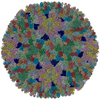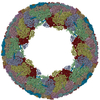+Search query
-Structure paper
| Title | The structure of a 12-segmented dsRNA reovirus: New insights into capsid stabilization and organization. |
|---|---|
| Journal, issue, pages | PLoS Pathog, Vol. 19, Issue 4, Page e1011341, Year 2023 |
| Publish date | Apr 21, 2023 |
 Authors Authors | Qinfen Zhang / Yuanzhu Gao / Matthew L Baker / Shanshan Liu / Xudong Jia / Haidong Xu / Jianguo He / Jason T Kaelber / Shaoping Weng / Wen Jiang /   |
| PubMed Abstract | Infecting a wide range of hosts, members of Reovirales (formerly Reoviridae) consist of a genome with different numbers of segmented double stranded RNAs (dsRNA) encapsulated by a proteinaceous shell ...Infecting a wide range of hosts, members of Reovirales (formerly Reoviridae) consist of a genome with different numbers of segmented double stranded RNAs (dsRNA) encapsulated by a proteinaceous shell and carry out genome replication and transcription inside the virion. Several cryo-electron microscopy (cryo-EM) structures of reoviruses with 9, 10 or 11 segmented dsRNA genomes have revealed insights into genome arrangement and transcription. However, the structure and genome arrangement of 12-segmented Reovirales members remain poorly understood. Using cryo-EM, we determined the structure of mud crab reovirus (MCRV), a 12-segmented dsRNA virus that is a putative member of Reovirales in the non-turreted Sedoreoviridae family, to near-atomic resolutions with icosahedral symmetry (3.1 Å) and without imposing icosahedral symmetry (3.4 Å). These structures revealed the organization of the major capsid proteins in two layers: an outer T = 13 layer consisting of VP12 trimers and unique VP11 clamps, and an inner T = 1 layer consisting of VP3 dimers. Additionally, ten RNA dependent RNA polymerases (RdRp) were well resolved just below the VP3 layer but were offset from the 5-fold axes and arranged with D5 symmetry, which has not previously been seen in other members of Reovirales. The N-termini of VP3 were shown to adopt four unique conformations; two of which anchor the RdRps, while the other two conformations are likely involved in genome organization and capsid stability. Taken together, these structures provide a new level of understanding for capsid stabilization and genome organization of segmented dsRNA viruses. |
 External links External links |  PLoS Pathog / PLoS Pathog /  PubMed:37083840 / PubMed:37083840 /  PubMed Central PubMed Central |
| Methods | EM (single particle) |
| Resolution | 3.1 - 3.7 Å |
| Structure data | EMDB-33403, PDB-7xr2: EMDB-33404, PDB-7xr3:  EMDB-33405: icosahedral reconstruction of mud crab reovirus in transcriptionally active state  EMDB-33406: D5 reconstruction of mud crab reovirus in transcriptionally active state |
| Source |
|
 Keywords Keywords |  VIRUS / VIRUS /  Reovirus / ds-RNA virus Reovirus / ds-RNA virus |
 Movie
Movie Controller
Controller Structure viewers
Structure viewers About Yorodumi Papers
About Yorodumi Papers







 scylla serrata reovirus sz-2007
scylla serrata reovirus sz-2007